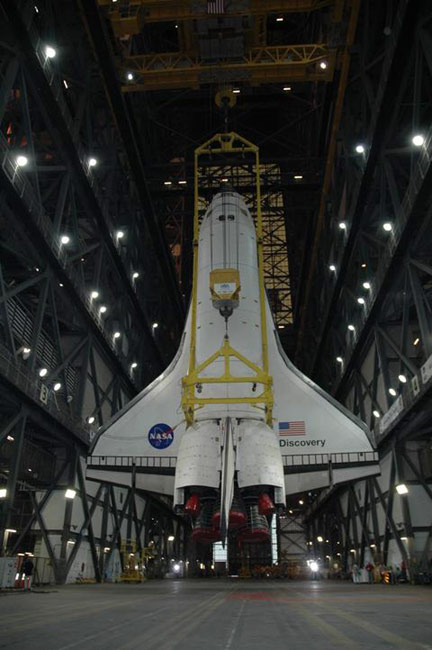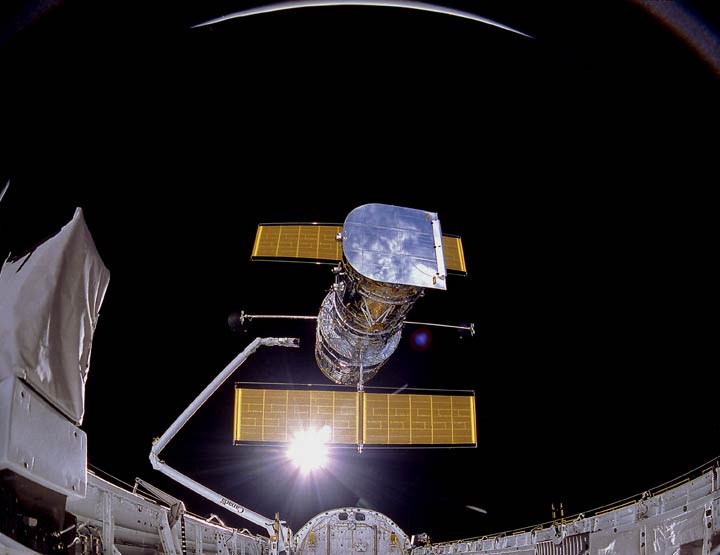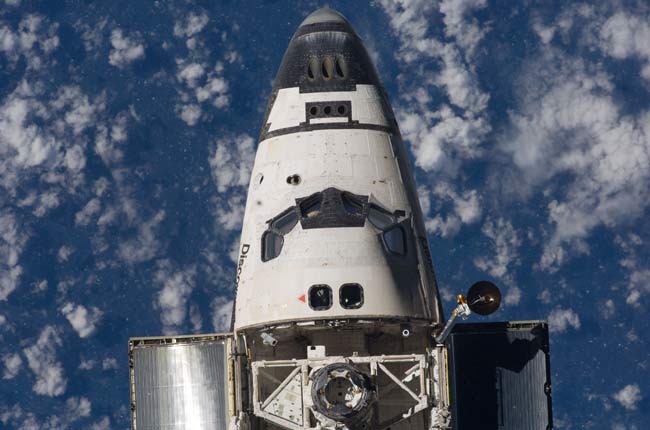Discovery: NASA's Busiest Shuttle

Discovery was the third shuttle to head into space, but it ended up flying the most missions: 39. Discovery also was the shuttle that did both "return to flight" missions after the Challenger and Columbia disasters.
In 39 voyages to space, Discovery crews launched the Hubble Space Telescope, sent the Ulysses spacecraft to study the sun and helped build the International Space Station.
Discovery was named after two sailing ships, according to NASA. One of those ships, commanded by Henry Hudson, was most famous for a voyage in 1610-11 to search for a waterway between the Pacific and Atlantic oceans. James Cook commanded another ship called Discovery when his crew was the first European group to set foot in the Hawaiian islands in 1778.
Discovery at a glance
- First flight: STS-41-D (Aug. 30 - Sept. 5, 1984
- Last flight: STS-133 (Feb. 24 - March 9, 2011)
- Number of missions: 39
- Time in space: 365 days, 22 hours, 39 minutes, 33 seconds
- Current location: Steven F. Udvar-Hazy Center (National Air and Space Museum) in Fairfax, Va.
- Notable: Flew the most missions of any space shuttle. Was the first space shuttle to return to flight after the Challenger and Columbia disasters. Payloads included the Hubble Space Telescope and the Ulysses spacecraft.
Construction history
Rockwell got the contract to start building Discovery in 1979. Discovery departed its manufacturing birthplace in Palmdale, Calif., in October 1983, and arrived at the Kennedy Space Center for flight preparation Nov. 9, 1983.
Discovery weighed in at 6,870 pounds less than Columbia, a product of Rockwell's experience in building two shuttles and a prototype so far (Columbia, Challenger and Enterprise).
In its career, Discovery also underwent two major upgrades in 1995 and 2002 for technological and safety modifications.
A pad abort
On June 26, 1984, Discovery was in the final moments of launching to space on STS-41D when the engines shut down seconds before launch. It was the shuttle's computers that initiated the abort, which happened when a fuel valve on Engine 3 didn't open as planned.
Minutes later, a hydrogen fire broke out and the pad's fire suppression system kicked in. According to crew member Mike Mullane in his memoirs Riding Rockets, the crew was a little befuddled as they watched water splashing across the windows. They weren't sure if it was best to leave, or to escape the shuttle. After some discussions, NASA and the crew decided to stay put.
"It was a decision that might have saved our lives," Mullane wrote. "The gas flame may have been as high as the cockpit, but since hydrogen burns clean we would not have seen it. We could have thrown open the hatch and run into a fire."
When it was safe to do so, the crew exited and got soaked by water from the fire suppression system. But the important thing was that they were okay. NASA took several weeks to fix the engine, and Discovery's STS-41D mission finally lifted off Aug. 30 with three satellites on board.
This was the first abort of the shuttle program; all told, five shuttle missions were called off just moments before launch, then sent into space at a later date. Another mission, STS-51F, had an early cutoff in Challenger's center engine about five minutes, 45 seconds into the launch. It went into orbit successfully.
Early flights and return to flight
NASA had an aggressive flight schedule for the shuttle in the early days of its program. The young Discovery flew two times in 1984 and four times in 1985, sending several satellites into space. Some of those satellites include Anik C-1 (Canada), ARABSAT-A and Australia's AUSSAT-1. Additionally, Discovery flew the first of a series of shuttle missions for the Department of Defense.
All of this began to change after the Challenger explosion of 1986. Satellite launches gradually shifted to one-use unmanned rockets for safety and cost considerations. The shuttle's mandate changed to being focused on science and station-building activities.
However, there still was a backlog of satellites to carry up through the shuttle. NASA's return to flight mission after Challenger was STS-26 – a Discovery mission.
The shuttle lofted a Tracking and Data Relay Satellite into space to provide enhanced communication between the ground and the shuttle. During that mission, a malfunction in the cabin raised temperatures to the mid-80s – a bit extreme for the shirtsleeve environment of the shuttle, but not unduly bad.
Then came a slew of satellite launches: another TDRS, Hubble, the Ulysses spacecraft and the Upper Atmosphere Research Satellite that infamously plunged to Earth in 2011. Discovery also flew a few more Department of Defense missions.

Science and stations
Science began to come more to the forefront in the early to mid-1990s. Discovery flew the International Microgravity Laboratory on STS-42 to study the effects of low gravity on humans and a bunch of other, tiny passengers: shrimp eggs, fruit fly eggs and lentil seedings.
STS-56, another science mission, was halted 11 seconds before one launch attempt due to an instrumentation problem. Once it launched on April 8, 1993, crew members focused on the interaction between the sun's energy and the Earth's atmosphere with an experiment called Atmospheric Laboratory for Applications and Science (ATLAS-2). The crew also used the Canadarm to temporarily deploy a small instrument platform that studied the solar wind and sun's corona.
Other notable missions in the 1990s included:
- STS-51, which was plagued by mechanical and other difficulties that led to multiple launch scrubs. The most spectacular took place three seconds before launch on Aug. 12, 1993, due to a faulty fuel flow sensor. The mission successfully launched Sept. 12, 1993.
- STS-60, which saw the first Russian cosmonaut launch on a U.S. spacecraft (note that the Apollo-Soyuz mission of 1975 saw U.S. and Russian crews dock their spacecraft in orbit). STS-60 was an important precursor to the Mir-space shuttle missions later in the 1990s.
- STS-82, the second servicing flight to the Hubble Space Telescope.
- STS-91, the final Mir docking of the space shuttle program.
- STS-95, which saw Mercury astronaut John Glenn make a triumphant return to space at age 77.

Return to flight redux
Discovery's primary mission in its latter years was building the International Space Station, but that was interrupted by the Columbia breakup of 2003. Foam falling from Columbia's external tank breached tiles on the wing. The shuttle broke up during re-entry, killing Columbia's seven crew members on Feb. 1.
Discovery carried the responsibility of being the first shuttle to fly again on July 26, 2005, almost two and a half years after Columbia's fatal flight.
NASA implemented new safety procedures ahead of the launch, starting with STS-114. Crew members now would spend hours of time examining the shuttle's belly tiles using a modified Canadarm and imaging system. Crew members did a spacewalk to test tile repair procedures in space. Also, NASA installed new ground-based and shuttle cameras to monitor launch debris.
NASA delayed flying further shuttle flights because of more foam debris during STS-114. The next mission, STS-121, flying with external tank modifications, went into space on July 4, 2006. Crew members again focused on new safety procedures. This heightened emphasis remained for the last six years of the shuttle program, even as construction of the station continued.
STS-133, Discovery's last mission, delivered the Permanent Multipurpose Module Leonardo and Robonaut 2 to the almost-completed space station. The shuttle safely touched down March 9, 2011.
Discovery's permanent home on Earth is the Stephen F. Udvar-Hazy airport annex of the Smithsonian National Air and Space Museum in Washington, D.C.
The shuttle landed in Washington on April 17, 2012, to replace shuttle prototype Enterprise, which retired to New York City. Shuttle and shuttle prototype met nose-to-nose in a special ceremony before Discovery went inside Udvar-Hazy for display, and Enterprise departed Washington for New York's Intrepid Sea, Air and Space Museum.
The other shuttles:
Join our Space Forums to keep talking space on the latest missions, night sky and more! And if you have a news tip, correction or comment, let us know at: community@space.com.
Get the Space.com Newsletter
Breaking space news, the latest updates on rocket launches, skywatching events and more!

Elizabeth Howell (she/her), Ph.D., was a staff writer in the spaceflight channel between 2022 and 2024 specializing in Canadian space news. She was contributing writer for Space.com for 10 years from 2012 to 2024. Elizabeth's reporting includes multiple exclusives with the White House, leading world coverage about a lost-and-found space tomato on the International Space Station, witnessing five human spaceflight launches on two continents, flying parabolic, working inside a spacesuit, and participating in a simulated Mars mission. Her latest book, "Why Am I Taller?" (ECW Press, 2022) is co-written with astronaut Dave Williams.










